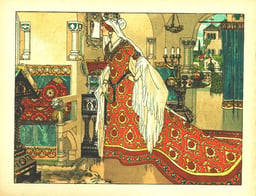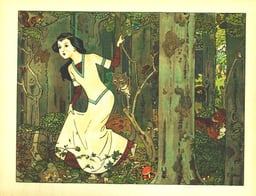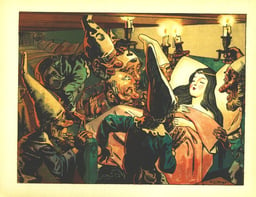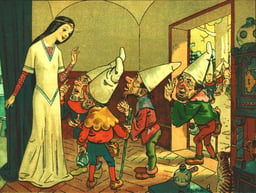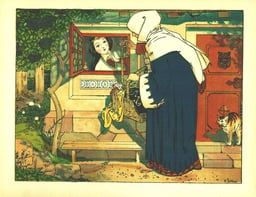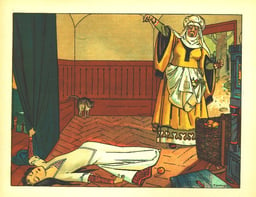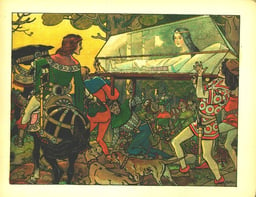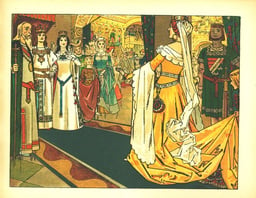Snow White
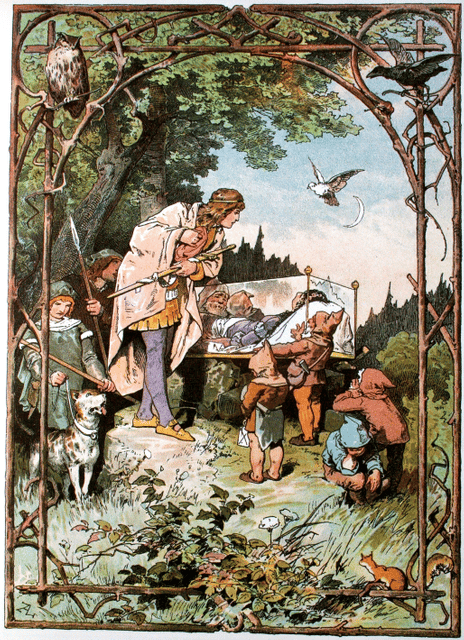
Snow White
"Snow White" is a 19th-century German fairy tale which is today known widely across the Western world. The Brothers Grimm published it in 1812 in the first edition of their collection Grimms' Fairy Tales. It was titled in German: Sneewittchen (in modern orthography Schneewittchen) and numbered as Tale 53. The name Sneewittchen was Low German and in the first version it was translated with Schneeweißchen. The Grimms completed their final revision of the story in 1854.[1][2]
The fairy tale features such elements as the magic mirror, the poisoned apple, the glass coffin, and the characters of the Evil Queen and the Seven Dwarfs. The seven dwarfs were first given individual names in the 1912 Broadway play Snow White and the Seven Dwarfs and then given different names in Walt Disney's 1937 film Snow White and the Seven Dwarfs. The Grimm story, which is commonly referred to as "Snow White",[3] should not be confused with the story of "Snow-White and Rose-Red" (in German "Schneeweißchen und Rosenrot"), another fairy tale collected by the Brothers Grimm.
In the Aarne–Thompson folklore classification, tales of this kind are grouped together as type 709, Snow White. Others of this kind include "Bella Venezia", "Myrsina", "Nourie Hadig", "Gold-Tree and Silver-Tree",[4] "The Young Slave", and "La petite Toute-Belle".
Story
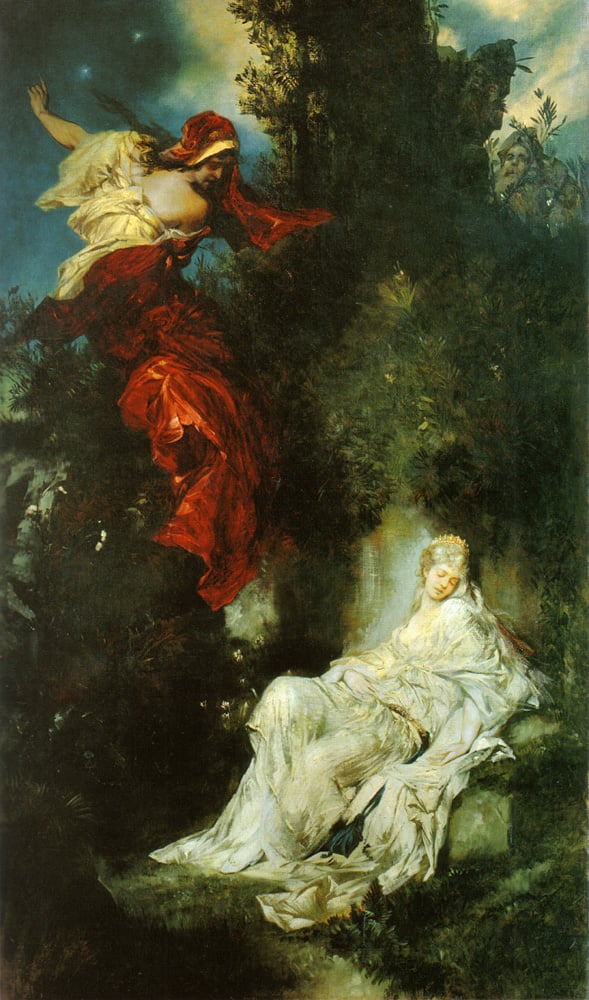
The fable's antagonist the Evil Queen with the protagonist Snow White as depicted in The Sleeping Snow White by Hans Makart (1872)
At the beginning of the story, a queen sits sewing at an open window during a winter snowfall when she pricks her finger with her needle, causing three drops of red blood to drip onto the freshly fallen white snow on the black windowsill. Then, she says to herself, "How I wish that I had a daughter that had skin as white as snow, lips as red as blood, and hair as black as ebony." Some time later, the queen gives birth to a baby daughter whom she names Snow White, but the queen dies in childbirth a short while later.[1][5]
A year later, Snow White's father, the king, marries again. His new wife is very beautiful, but she is a vain and wicked woman who practices witchcraft. The new queen possesses a magic mirror, which she asks every morning, "Magic mirror on the wall, who is the fairest one of all?" The mirror always tells the queen that she is the fairest. The queen is always pleased with that, because the magic mirror never lies. But as Snow White grows up, she becomes more beautiful each day and even more beautiful than her stepmother. When the queen asks her mirror one day, the mirror tells her that Snow White is the fairest.[1][5]
This gives the queen a great shock. She becomes envious, and from that moment on, her heart turns against Snow White, whom the queen grows to hate increasingly with time. Eventually, the angry queen orders a huntsman to take Snow White into the forest to be killed. As proof that Snow White is dead, the queen demands that he returns with her heart, which she will consume in order to become as beautiful as Snow White. The huntsman takes Snow White into the forest, but after raising his knife he finds himself unable to kill her. When Snow White finds out about her stepmother's plan, she tearfully begs, "Spare me this mockery of justice! I will run away into the forest and never come home again!" The huntsman reluctantly agrees to spare Snow White and brings the queen the heart of a wild animal instead.[1][5]
After wandering through the forest for hours, Snow White discovers a tiny cottage belonging to a group of seven dwarfs. Since no one is at home, she eats some of the tiny meals, drinks some of their wine, and then tests all the beds. Finally, the last bed is comfortable enough for her and she falls asleep. When the dwarfs return home, they immediately become aware that there is a burglar in their house, because everything in their home is in disorder. Prowling about frantically, they head upstairs and discover the sleeping Snow White. She wakes up and explains to them what happened, and the dwarfs take pity on her and let her stay with them in exchange for housekeeping. They warn her to be careful when alone at home and to let no one in while they are working in the mountains.[1][5]
Meanwhile, the queen, believing that Snow White is dead, asks her mirror once again: "Magic mirror on the wall, who is the fairest one of all?" The mirror tells her that Snow White is still the fairest in the land.[1] The queen is furious when she learns that Snow White is still alive, and decides to kill the girl herself. She appears at the dwarfs' cottage, disguised as an old peddler, and offers Snow White colorful, silky laced bodices as a present; the queen laces her up so tightly that Snow White faints. The dwarfs return just in time, and Snow White revives when the dwarfs loosen the laces.[1][5] Upon hearing from her Magic Mirror that Snow White still lives, the queen dresses as a comb seller and convinces Snow White to take a beautiful comb as a present; she brushes Snow White's hair with the poisoned comb. The girl faints again, but she is again revived by the dwarfs when they remove the comb from her hair. The Magic Mirror informs the queen that her plan has failed again and Snow White is not dead, so the queen disguises herself as a farmer's wife and offers Snow White a poisoned apple. Snow White is hesitant to accept it, so the queen cuts the apple in half, eating the white (harmless) half and giving the red poisoned half to Snow White. The girl eagerly takes a bite and falls down unconscious. This time, the dwarfs are unable to revive Snow White. Assuming that she is dead, they place her in a glass casket.[1][5]
Three days later, a prince stumbles upon Snow White lying in her glass coffin during a hunting trip. After hearing her story from the seven dwarfs, the prince is allowed to take Snow White to her proper resting place. While Snow White is being transported, one of the prince's servants trips and loses his balance. This dislodges the piece of poisoned apple from Snow White's throat, reviving her. In the first edition, Snow White is carried to the palace without mishap, but later a servant, frustrated by the inconvenience caused by the prince's fawning over her, hits the body and dislodges the apple.[6] The prince is overjoyed, and declares his love for Snow White. Snow White agrees to marry him.
Snow White and the prince invite everyone to their wedding party, including Snow White's stepmother.
The queen, still believing that Snow White is dead, again asks her magic mirror who is the fairest in the land. The mirror says that the prince's bride is the fairest. Not knowing that the bride is her stepdaughter, the queen arrives at the wedding to investigate. Frozen with rage and fear, she tries to sow chaos but the prince recognizes her as a threat. He orders that she wear a pair of red-hot iron slippers and dance in them until she drops dead for the attempted murder of Snow White.
Inspiration
Many scholars have theorized about the possible origins of the tale. In 1994, a German historian named Eckhard Sander published Schneewittchen: Märchen oder Wahrheit? (Snow White: Fairy Tale or Truth?), claiming he had uncovered an account that may have inspired the story that first appeared in Grimm’s Fairy Tales. According to Sander, the character of Snow White was based on the life of Margaretha von Waldeck, a German countess born to Philip IV in 1533. At the age of 16, Margarete was forced by her stepmother, Katharina of Hatzfeld, to move away to Brussels. There, Margarete fell in love with a prince who would later become Philip II of Spain. Margarete’s father and stepmother disapproved of the relationship as it was ‘politically inconvenient’. Margarete mysteriously died at the age of 21, apparently having been poisoned. Historical accounts point to the King of Spain who, in opposing the romance, may have dispatched Spanish agents to murder Margarete.[7]
Scholar Graham Anderson compares the story of Snow White to the Roman legend of Chione, recorded in Ovid's Metamorphoses. The name Chione means "Snow" in Greek and, in the story, she is described as the most beautiful woman in the land, so beautiful that the gods Apollo and Mercury both fell in love with her. Mercury put her to sleep with the touch of his caduceus and raped her in her sleep. Then Apollo, disguised as an old crone, approached her and raped her again. These affections led Chione to openly boast that she was more beautiful than the goddess Diana herself, resulting in Diana shooting her through the tongue with an arrow.[8][9]
Karlheinz Bartels, a pharmacist and scholar from Lohr am Main, a town in northwestern Bavaria, found evidence that Snow White was Maria Sophia Margarethe Catharina, Baroness von und zu Erthal, who was born in Lohr on June 25, 1725.[10][11] Her father, Philipp Christoph von und zu Erthal, was the local representative of the Prince Elector of Mainz.[12] After the death of Maria Sophia’s birth mother in 1738, her father remarried in 1743. The stepmother, Claudia Elisabeth von Reichenstein, was domineering and employed her new position to the advantage of her children from her first marriage. A magic mirror referred to as “The Talking Mirror”, known as always telling the truth, can still be viewed today in the Spessart Museum in the Lohr Castle, where Maria Sophia’s stepmother lived. This mirror was presumably a present from Maria Sophia’s father to his second wife. It was a product of the Lohr Mirror Manufacture (Kurmainzische Spiegelmanufaktur).[13] Her gravestone was found in 2019.[14]
Variations
The principal studies of traditional Snow White variants are Ernst Böklen's, Schneewittchen Studien of 1910, which (re)prints fifty Snow White variants,[15] and studies by Steven Swann Jones.[16] In their first edition, the Brothers Grimm published the version they had first collected, in which the villain of the piece is Snow White's jealous biological mother. In a version sent to another folklorist prior to the first edition, additionally, she does not order a servant to take her to the woods, but takes her there herself to gather flowers and abandons her; in the first edition, this task was transferred to a servant.[17] It is believed that the change to a stepmother in later editions was to tone down the story for children.[18]
A popular version of Snow White is the 1937 American animated film Snow White and the Seven Dwarfs by Walt Disney. Disney's variation of Snow White gave the dwarfs names and included a singing Snow White. The Disney film also is the only version in which Snow White and her prince meet before she bites the apple; in fact, it is this meeting that sets the plot in motion. Instead of her lungs and liver, as written in the original, the huntsman is asked by the queen to bring back Snow White’s heart. While the heart is mentioned, it is never shown in the box. Snow White is much more mature (about 14). And she is discovered by the dwarfs after cleaning the house, not vandalizing it. Furthermore, in the Disney movie the evil queen tries only once to kill Snow White (by a poisoned apple) and fails (this was likely to save time). She then dies by falling down a cliff and being crushed by a boulder, after the dwarfs had chased her through the forest. In the original, the queen is forced to dance to death.[19]
Many later versions omit the Queen's attempted cannibalism, eating what she believed to be the lungs and liver of Snow White. This may be a reference to old Slavic mythology which includes tales of witches eating human hearts.
In other traditions
Many other variations of the story exist across and outside Europe. In some of these variations the dwarfs are robbers, while the magic mirror is a dialogue with the sun or moon.
In a version from Albania, collected by Johann Georg von Hahn,[20] the main character lives with 40 dragons, and her sleep is caused by a ring. The beginning of the story has a twist, in that a teacher urges the heroine to kill her evil stepmother so that she would take her place. The origin of this tale is debated; it is likely no older than the Middle Ages. In fact, there are possibly two Albanian versions of Snow White: one in which her stepmother tries to kill her, and another in which her two jealous sisters try to kill her.
"The Jealous Sisters" is another Albanian fairy tale. In both fairy tales the death is caused by a ring.[21]
Bidasari is a Malay tale written around 1750 which tells the story of a witch queen who asks her magic mirror about the prettiest lady in the kingdom.
In parallel to the stepmother's question of her magic mirror, the Indian epic poem Padmavat (1540) includes the line: "Who is more beautiful, I or Padmavati?, Queen Nagamati asks her new parrot, and it gives a displeasing reply...";
Nourie Hadig from Armenia was the daughter of a woman who asked the Moon, "Who is the most beautiful in the world?", and the response is always "Nourie Hadig". The mother plots to kill her daughter.[22][23]
The story in Russian writer Alexander Pushkin's poem The Tale of the Dead Princess and the Seven Knights (1833) is similar to that of Snow White, with knights replacing dwarfs.[24]
Media
In film
Snow White (1916), a silent film by Famous Players-Lasky produced by Adolph Zukor and Daniel Frohman, directed by J. Searle Dawley, and starring Marguerite Clark, Creighton Hale, and Dorothy Cumming.
Snow-White (1933), also known as Betty Boop in Snow-White, a film in the Betty Boop series from Max Fleischer's Fleischer Studios.
Snow White and the Seven Dwarfs (1937), an animated Disney film based on the fairy tale, featuring Adriana Caselotti as the voice of Snow White.
I sette nani alla riscossa (The Seven Dwarfs to the Rescue) (1951), an Italian film based on the fairy tale.
Schneewittchen und die sieben Zwerge (1955), a German live-action adaptation of the fairy tale.
Snow White and the Seven Fellows (1955), a Hong Kong film as Chow Sze-luk, Lo Yu-kei Dirs
Snow White and the Three Stooges (1961), starring the Three Stooges with Carol Heiss as Snow White and Patricia Medina as the Evil Queen.
Snow White (1962), an East German fairy tale film directed by Gottfried Kolditz.
Pamuk Prenses ve 7 Cüceler (1970), a Turkish live-action remake of the 1937 Disney film.
Snow White (1987), starring Diana Rigg as the Evil Queen and Nicola Stapleton and Sarah Patterson both as Snow White.
Amada Anime Series: Super Mario Bros. (1989), a three-part OVA series featuring Mario characters in different fairy tales.
Schneewittchen und das Geheimnis der Zwerge (1992), a German adaptation of the fairy tale.
"Snow White" (1994), a short story written by James Finn Garner, from Politically Correct Bedtime Stories: Modern Tales For Our Life & Times.
Snow White: A Tale of Terror (1997), starring Sam Neill as Snow White's father, Sigourney Weaver as the Evil Queen, and Monica Keena as Snow White.
Snow White: The Fairest of Them All (2001), starring Kristin Kreuk as Snow White and Miranda Richardson as Queen Elspeth.
The Brothers Grimm (2005), an adventure fantasy film directed by Terry Gilliam and starring Matt Damon, Heath Ledger, and Lena Headey.
Schneewittchen (2009), a German made-for-television film starring Laura Berlin as Snow White.
Blancanieves (2012), a silent Spanish film based on the fairy tale.
Grimm's Snow White (2012), starring Eliza Bennett as Snow White and Jane March as the Evil Queen Gwendolyn.
Mirror Mirror (2012), starring Julia Roberts as the Evil Queen Clementianna,[25] Lily Collins as Snow White, Armie Hammer as Prince Andrew Alcott, and Nathan Lane as Brighton, the Queen's majordomo.[26]
Snow White and the Huntsman (2012), starring Kristen Stewart, Charlize Theron, Chris Hemsworth, and Sam Claflin.
The Huntsman: Winter's War (2016), which features Snow White as a minor character.
Charming (2018), an animated film featuring Snow White as one of the princesses, featuring the voice of Avril Lavigne.
Red Shoes and the Seven Dwarfs (2019), an upcoming Korean-American animated film based on the fairy tale, featuring the voice of Chloë Grace Moretz.
In television
Faerie Tale Theatre (1984) has an episode based on the fairy tale starring Vanessa Redgrave as the Evil Queen, Elizabeth McGovern as Snow White, and Vincent Price as the Magic Mirror.
A 1984 episode of Alvin & the Chipmunks called Snow Wrong based on the fairy tale. Brittany of The Chipettes as Snow White.
The 10th Kingdom (2000) is a TV miniseries featuring Snow White as a major character.
Once Upon a Time (2011) is a TV series featuring Snow White, Prince Charming, their daughter Emma Swan, and the Evil Queen as the main characters.
In literature
Snow White (1967), a postmodern novel by Donald Barthelme which describes the lives of Snow White and the dwarfs.
Snow White and the Seven Dwarfs (1971), a poem by Anne Sexton in her collection Transformations, in which she re-envisions sixteen of the Grimm's Fairy Tales.[27]
Snow White in New York (1986), a picture book by Fiona French set in 1920's New York.
"Snow, Glass, Apples", a 1994 short story written by Neil Gaiman, which all but explicitly rewrites the tale to make Snow White a vampire-like entity that is opposed by the Queen, while the prince is strongly implied to have necrophiliac tastes.
Tímakistan (2013), a novel by Andri Snær Magnason, an adaptation of Snow White.
Boy, Snow, Bird (2014), a novel by Helen Oyeyemi which adapts the Snow White story as a fable about race and cultural ideas of beauty.[28]
Winter (2015), a novel by Marissa Meyer loosely based on the story of Snow White.
Sadie: An Amish Retelling of Snow White (2018) by Sarah Price
Shattered Snow (2019), a time travel novel by Rachel Huffmire, ties together the life of Margaretha von Waldeck and the Grimm Brothers’ rendition of Snow White.
In theatre
The story of Snow White is a popular theme for British pantomime.
Snow White and the Seven Dwarfs (1912), a play by Jessie Braham
In other media
Charmed (2008), an album by Sarah Pinsker, features a song called "Twice the Prince" in which Snow White realizes that she prefers a dwarf to Prince Charming.
The Haunt of Fear (1953) was a horror comic which featured a gruesome re-imaging of Snow White.
Sonne (2001) is a music video for the song by Neue Deutsche Härte band Rammstein, where the band are dwarfs mining gold for Snow White.
Fables (2002), a comic created by Bill Willingham, features Snow White as a major character in the series.
Snow White with the Red Hair (2006) is a manga which opens with a loose adaptation of the fairy tale, with a wicked prince pursuing a girl with strikingly red hair.
The Boys (2011), Girls' Generation's third studio album, features a concept photo by Taeyeon inspired by Snow White.
RWBY (2013) is a web series which features characters called "Weiss Schnee" and "Klein Sieben", German for "White Snow" and "Small Seven" (grammatically incorrect, though, since it would be "Weisser Schnee" and "Kleine Sieben").
The Wolf Among Us (2013), the Telltale Games video game based on the comic book series Fables
Trademark
In 2013, the United States Patent and Trademark Office issued a trademark to Disney Enterprises, Inc. for the name "Snow White" that covers all live and recorded movie, television, radio, stage, computer, Internet, news, and photographic entertainment uses, excluding literary works of fiction and nonfiction.[29]
Religious interpretation
Other interpretations
The Brothers Grimm story of “Snow White” takes an unusual turn from its other fairy-tale counterparts in that it can be interpreted as a story with a lesson centered around desirable qualities for women. The Queen’s—Snow White’s step-mother—defining characteristic is her cunning, or intelligence, whereas Snow White’s is her beauty.[32] Snow White consistently foils the Queen’s jealous attempts to kill her because strangers pity and help her due to her childlike innocence and beauty. For example, the huntsman, who was ordered to kill Snow White, describes her as a “pretty child” and lets her go, which carries over to when the seven dwarfs decide not to cast her out when they find Snow White in their home. Even when the Queen devises the poison apple and kills Snow White, she is saved by the Prince because he finds her to be “the fairest of them all.” The Queen dies at the end of the story while Snow White lives happily ever after with the Prince, implying that the Queen’s cunning was not enough to counter the power of Snow White’s elegance. This suggests that the moral of the story is that beauty is more desirable than intelligence. Despite the modern connotations of this concept, one must consider the time period at which the story was written; Snow White as told by the Brothers Grimm was first published in 1812, where at the time, it was arguably common place for women to be viewed as objects instead of people.
See also
Snežana, a Slavic female name meaning "snow woman" with a similar connotation to "Snow White"
"Snow-White-Fire-Red", an Italian fairy tale
"Sleeping Beauty"
"The Glass Coffin"
"Udea and her Seven Brothers"
